Changes in Rainfall in Sierra Leone: 1981–2018
Abstract
1. Introduction
2. Objective
- Quantify trends in rainfall over the past few decades and determine if the trends are statistically significant.
- Examine the spatial patterns in rainfall at a resolution suitable for planning.
- Rainfall during the planting season, (mid-March to the end of May);
- Start date of the main rainy season;
- How erratic the start of the rainy season is;
- Length of the rainy season and growing season;
- Extreme events, as the annual maximum one-day and seven-day rainfall totals.
3. Method
- ○
- Annual total rainfall (1 January to 31 December).
- ○
- Early season rainfall (15 March to 31 May).
- ○
- Day number of the start of the main rainy season (the main rainy season being the longest period when the soil moisture content is continuously above 10 mm). In most cases, this is within one week of the start of the rainy season, as estimated by the AA method.
- ○
- A measure of how erratic the early rainfall is (number of days between the first day that soil moisture exceeds 10 mm and the start of the main rainy season defined above); this variability is not easily captured with the AA method.
- ○
- Length of the rainy season estimated as the number of “wet” days (more than 10 mm/day).
- ○
- Length of the growing season is estimated as the number of days when the soil moisture content is above 10 mm; this is consistently a month to six weeks after the end of the rainy season, as calculated by the AA method because of the effect of the soil water storage.
- ○
- Extreme events which are characterized as the annual maximum 1-day and annual 7-day maximum rainfall totals. A 5-day max (RX5Day in [27]) is the convention, but farmers in Sierra Leone often talk of 7-day rains and consistently claim they are now much less common.
4. Results
4.1. Annual Rainfall
4.2. Early Season Rainfall
4.3. Start of the Rainy Season
4.4. Number of Days with Rain Greater than 10 mm and Length of the Growing Season
4.5. Peak One-Day Rainfall and Seven-Day Rainfall
5. Discussion
6. Conclusions
Author Contributions
Funding
Acknowledgments
Conflicts of Interest
References
- Richards, P. Fighting for the Rain Forest. War, Youth & Resources in Sierra Leone; James Currey: Oxford, UK, 1996. [Google Scholar]
- Buhaug, H. Climate not to blame for African civil wars. Proc. Natl. Acad. Sci. USA 2010, 107, 16477–16482. [Google Scholar] [CrossRef] [PubMed]
- Barnett, J.; Adger, N. Climate change, human security and violent conflict. Polit. Geogr. 2007, 26, 639–655. [Google Scholar] [CrossRef]
- Enfield, G.H.; Nash, D.J. Drought, desiccation and discourse: Missionary correspondence and Nineteenth-Century climate change in central southern Africa. Geogr. J. 2002, 158, 33–47. [Google Scholar] [CrossRef] [PubMed]
- Nicholson, S.E.; Some, B.; Kone, B. An Analysis of Recent Rainfall Conditions in West Africa, Including the Rainy Seasons of the 1997 El Niño and the 1998 La Niña Years. J. Clim. 2000, 13, 2628–2640. [Google Scholar] [CrossRef]
- World Bank. Republic of Sierra Leone priorities for Sustainable Growth and Poverty Reduction Systematic Country Diagnostics; World Bank Group Report 115408-SL; World Bank: Washington, DC, USA, 2018. [Google Scholar]
- UNDP. 2019. Available online: https://www.adaptation-undp.org/explore/western-africa/sierra-leone (accessed on 1 September 2019).
- RSL (Republic of Sierra Leone). Second National Communication of Climate Change. 2012. Available online: https://unfccc.int/resource/docs/natc/slenc2.pdf (accessed on 1 September 2019).
- Maplecroft. 2014. Available online: https://www.maplecroft.com/insights/analysis/global-economic-output-forecast-faces-high-or-extreme-climate-change-risks-by-2025/ (accessed on 1 September 2019).
- Nikulin, G.; Jones, C.; Giorgi, F.; Asrar, G.; Buchner, M.; Cerezo-Mota, R.; Christensen, O.B.; DeQue, M.; Fernandez, J.; Hansler, A.; et al. Precipitation Climatology in an Ensemble of CORDEX-Africa Regional Climate Simulations. J. Clim. 2012, 25, 6057–6079. [Google Scholar] [CrossRef]
- Stanturf, J.; Goodrick, S.; Warren, M.; Stegall, C.; Williams, M. Climate Change Assessment of Liberia; USDA Forest Service Office of International Programs: Washington, DC, USA, 2013. [Google Scholar]
- Aguilar, E.; Barry, A.A.; Brunet, M.; Ekang, L.; Fernandes, A.; Massoukina, M.; Mbah, J.; Mhanda, A.; Nascimento, D.J.; Peterson, T.; et al. Changes in temperature and precipitation extremes in western central Africa, Guinea Conakry, and Zimbabwe, 1955–2006. J. Geophys. Res. 2009, 114, D02115. [Google Scholar] [CrossRef]
- New, M.; Hewitson, B.; Stephenson, D.B.; Tsiga, A.; Kruger, A.; Manhique, A.; Gomez, B.; Coelho, C.A.S.; Masisi, D.N.; Kululanga, E.; et al. Evidence of trends in daily climate extremes over southern and west Africa. J. Geophys. Res. 2006, 111, D14102. [Google Scholar] [CrossRef]
- World Bank. Climate Change Knowledge Portal. 2019. Available online: https://climateknowledgeportal.worldbank.org/country/sierra-leone (accessed on 1 September 2019).
- WMO (World Meteorological Organisation). 2019. Available online: https://cpdb.wmo.int/sierra-leone (accessed on 1 September 2019).
- SSL (Statistics Sierra Leone). The Statistical Digest 2007–2013 Edition; Statistics Sierra Leone: Freetown, Sierra Leone, 2014. [Google Scholar]
- Taylor, E.T.; Kamara, A.S.; Bockarie, A. Rainfall Pattern in Freetown, Sierra Leone: From a Retrospective Viewpoint. In Proceedings of the International Conference ADAPTtoCLIMATE, Nicosia, Cyprus, 27–28 March 2014. [Google Scholar]
- Kamara, M.Y. Investigating the Variation of Intra-Seasonal Rainfall Characteristics in Sierra Leone. Master’s Thesis, Department of Meteorology, University of Nairobi, Nairobi, Kenya, 2016. [Google Scholar]
- Hayward, D.; Clarke, R.T. Relationship between rainfall, altitude and distance from the sea in the Freetown Peninsula, Sierra Leone. Hydrol. Sci. J. 1996, 41, 377–384. [Google Scholar] [CrossRef]
- Beck, H.E.; Pan, M.; Roy, T.; Weedon, G.P.; Pappenberger, F.; van Dijk, A.I.J.M.; Huffman, G.J.; Adler, R.F.; Wood, E.F. Daily evaluation of 26 precipitation datasets using Stage-IV gauge-radar data for the CONUS. Hydrol. Earth Syst. Sci. 2019, 23, 207–224. [Google Scholar] [CrossRef]
- Funk, C.; Peterson, P.; Landsfeld, M.; Pedreros, D.; Verdin, J.; Shukla, S.; Husak, G.; Rowland, J.; Harrison, L.; Hoell, A.; et al. The climate hazards infrared precipitation with stations—A new environmental record for monitoring extremes. Sci. Data 2015, 2, 150066. [Google Scholar] [CrossRef]
- VAM. Available online: https://dataviz.vam.wfp.org/seasonal_explorer/rainfall_vegetation/visualizations (accessed on 1 September 2019).
- Food Security Working Group. Rapid Assessment on the Effects of the Erratic Rainfall Patterns on Smallholder Farmers in Sierra Leone—July 2018; Unpublished Report; FSWG: Freetown, Sierra Leone, 2000. [Google Scholar]
- Detsch, F. 2019. Available online: https://rdrr.io/github/environmentalinformatics-marburg/heavyRain/man/getCHIRPS.html#heading-4 (accessed on 1September 2019).
- R Core Team. R: A Language and Environment for Statistical Computing; R Foundation for Statistical Computing: Vienna, Austria, 2018; Available online: https://www.R-project.org/ (accessed on 1 September 2019).
- Zhang, X.; Alexander, L.; Hegerl, G.C.; Jones, P.; Tank, A.K.; Peterson, T.C.; Trewin, B.; Zwiers, F.W. Indices for monitoring changes in extremes based on daily temperature and precipitation data. WIREs Clim. Chang. 2011, 2, 851–870. [Google Scholar] [CrossRef]
- Marengo, J.A.; Liebmann, B.; Kousky, V.E.; Filizola, N.P.; Wainer, I.C. Onset and end of the rainy season in the Brazilian Amazon basin. J. Clim. 2001, 14, 833–852. [Google Scholar] [CrossRef]
- Arvor, D.; Dubreuil, V.; Ronchail, J.; Simoes, M.; Funatsu, B.M. Spatial patterns of rainfall regimes related to levels of double cropping agriculture systems in Mato Grosso (Brazil). International. J. Climatol. 2014, 34, 2622–2633. [Google Scholar] [CrossRef]
- Leenaars, J.G.B.; Hengl, T.; González, M.R.; de Jesus, J.S.M.; Heuvelink, G.B.M.; Wolf, J.; van Bussel, L.G.J.; Claessens, L.; Yang, H.; Cassman, K.G. Root Zone Plant-Available Water Holding Capacity of the Sub-Saharan Africa Soil, Version 1.0. Gridded Functional Soil Information (Dataset RZ-PAWHC SSA v. 1.0); ISRIC Report 2015/02. Collaboration project of Africa Soil Information Service (AfSIS) and Global Yield Gap and Water Productivity Atlas (GYGA); ISRIC—World Soil Information: Wageningen, The Netherlands, 2015. [Google Scholar]
- FAO. Sustainable rice production for food security. In Proceedings of the 20th Session of the International Rice Commission, Bangkok, Thailand, 23–26 July 2002. [Google Scholar]
- Ropelewski, C.F.; Halpert, M.S. Global and Regional Scale Precipitation Patterns associated with the El Niño/Southern Oscillation. Mon. Weather Rev. 1987, 1115, 1606–1626. [Google Scholar] [CrossRef]
- Jury, M.R.; Enfield, D.B.; Mélice, J.-L. Tropical monsoons around Africa: Stability of El Niño–Southern Oscillation associations and links with continental climate. J. Geophys. Res. 2002, 107, 3151. [Google Scholar] [CrossRef]
- FEWS-NET. Available online: http://fews.net/fews-data/335 (accessed on 1 September 2019).
- Kiladis, G.N.; Diaz, H.F. Global climate anomalies associated with extremes in the Southern Oscillation. J. Clim. 1989, 2, 1069–1090. [Google Scholar] [CrossRef]
- Timmermann, A.; Oberhuber, J.; Bacher, A.; Esch, M.; Latif, M.; Roecknew, E. Increased El Niño frequency in a climate model forced by future greenhouse warming. Nature 1999, 398, 694–697. [Google Scholar] [CrossRef]
- Munro, P.G. Deforestation: Constructing problems and solutions on Sierra Leone’s Peninsula. J. Polit. Ecol. 2009, 16, 104–122. [Google Scholar] [CrossRef][Green Version]
- Leite-Filho, A.T.; de Sousa Pontes, V.Y.; Costa, M.H. The duration of dry spells in southern Amazonia. JGR Atmos. 2019, 124, 5268–5281. [Google Scholar]
- Mansaray, L.R.; Huang, J.; Kamara, A.A. Mapping deforestation and urban expansion in Freetown Sierra Leone, from pre- to post-war economic recovery. Environ. Monit. Assess. 2016, 188, 470. [Google Scholar] [CrossRef]
- Ávila, A.; Justino, F.; Wilson, A.; Bromwich, D.; Amorim, M. Recent precipitation trends, flash floods and landslides in southern Brazil. Environ. Res. Lett. 2016, 11, 114029. [Google Scholar] [CrossRef]
- Wadsworth, R.A.; Lebbie, A.R. What happened to the forests of Sierra Leone? Land 2019, 8, 80. [Google Scholar] [CrossRef]
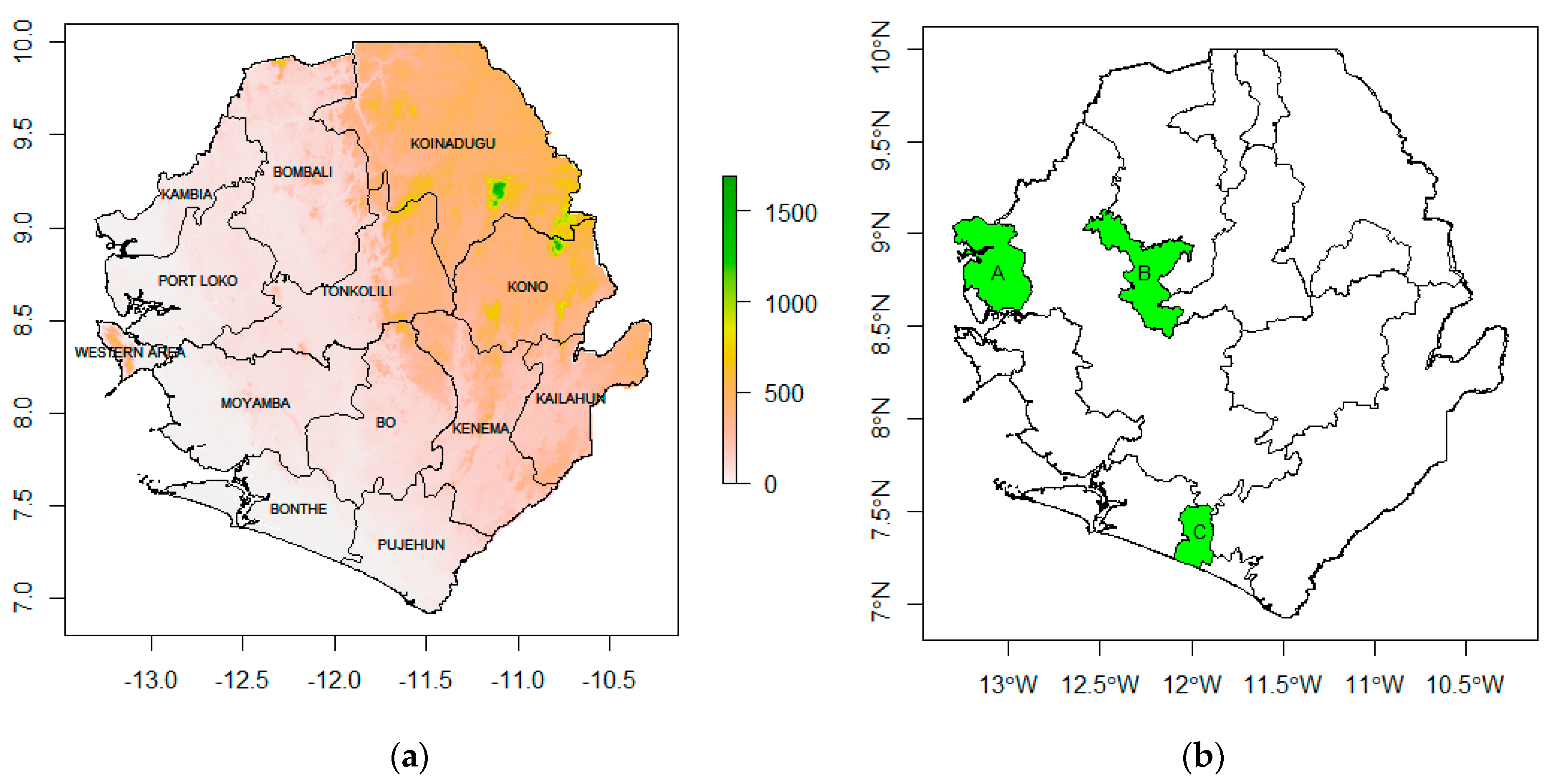
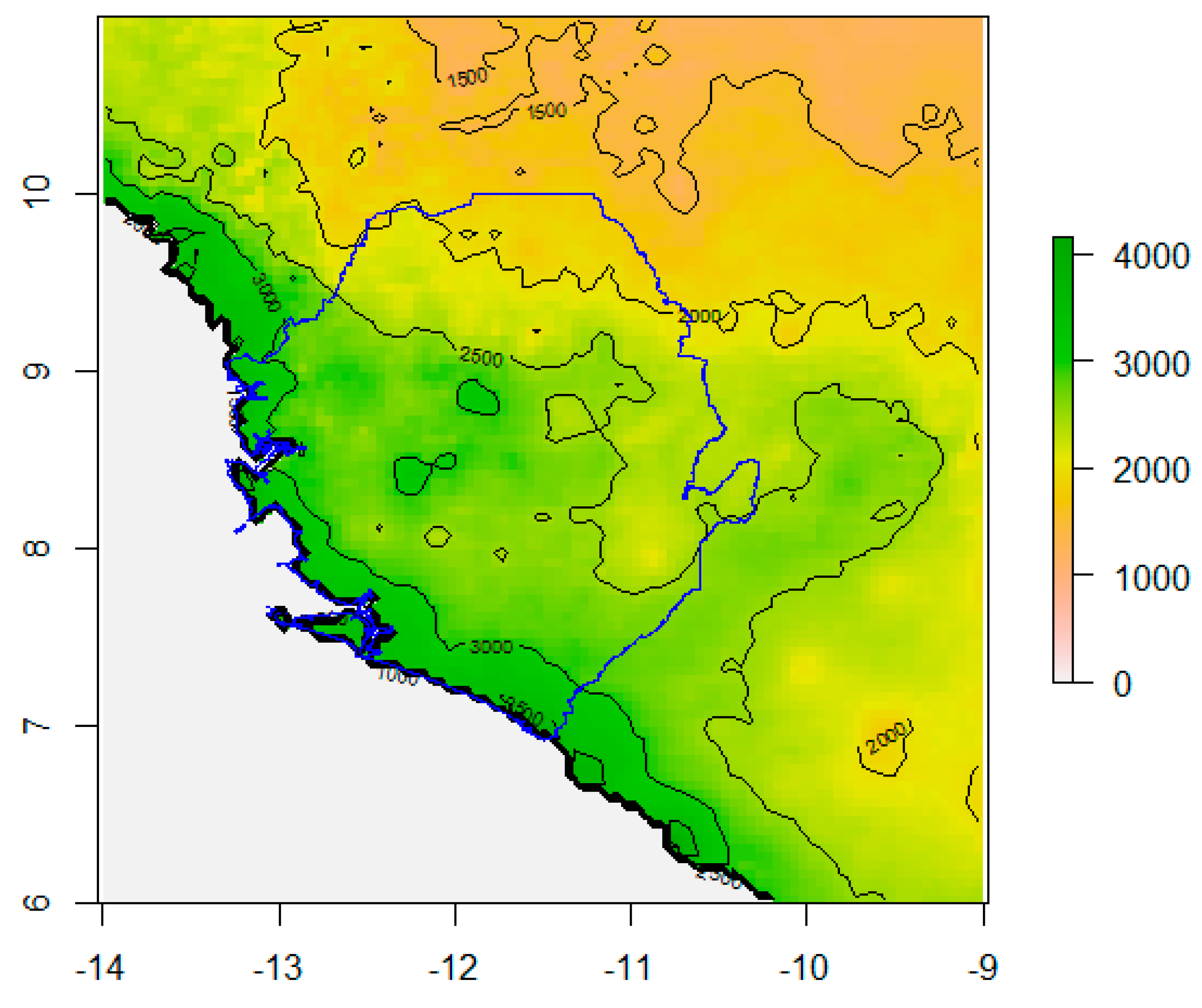
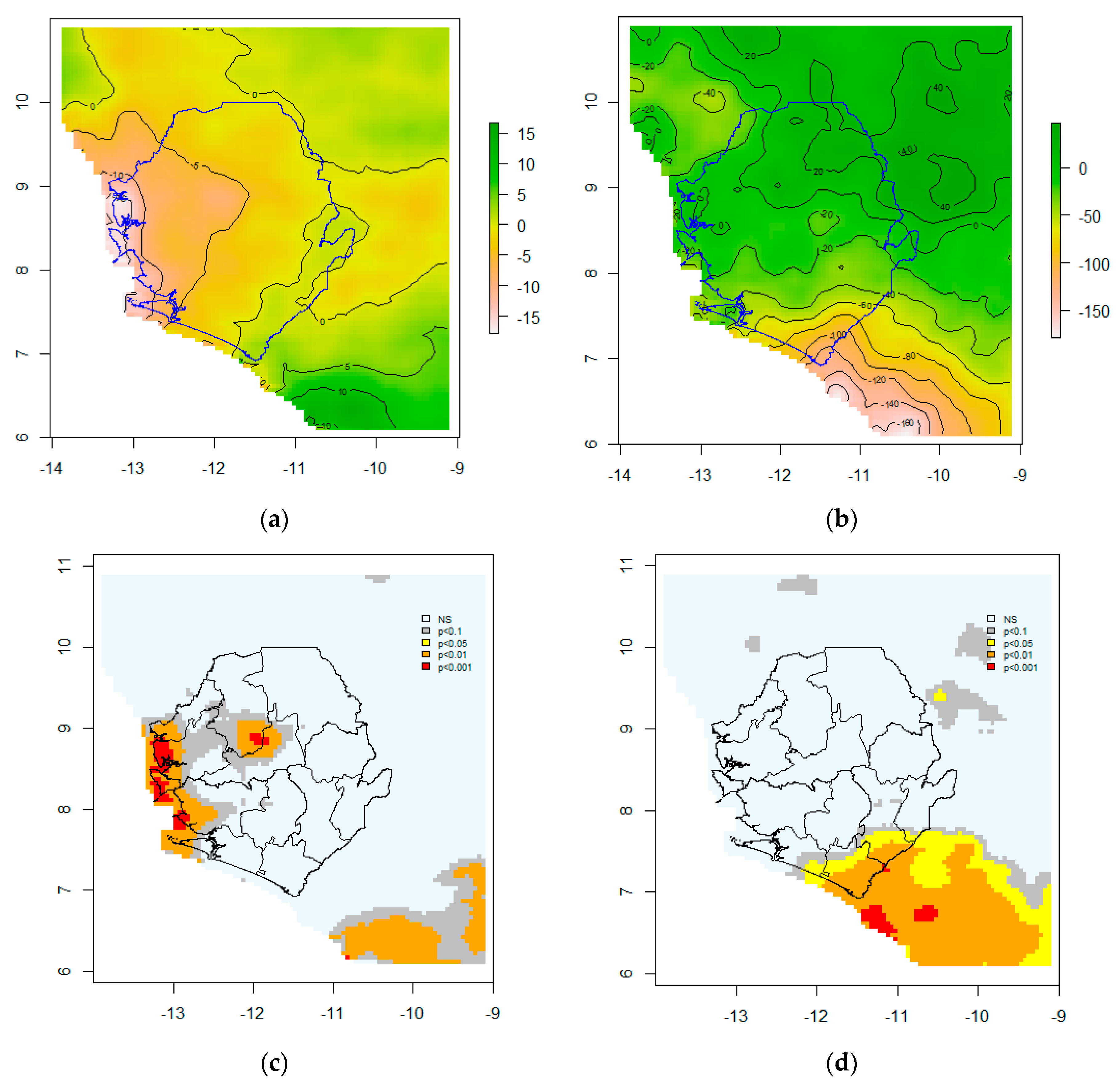
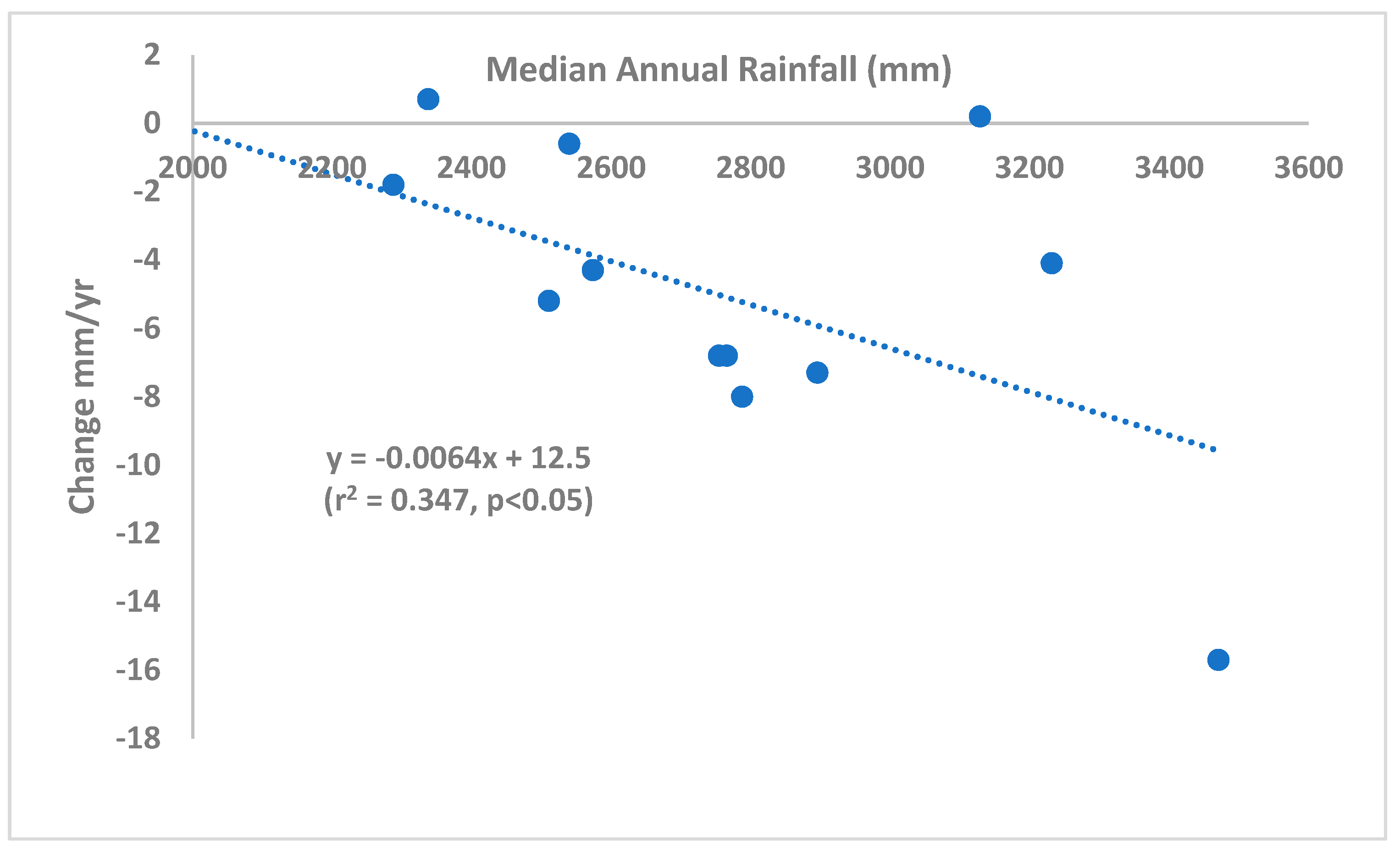
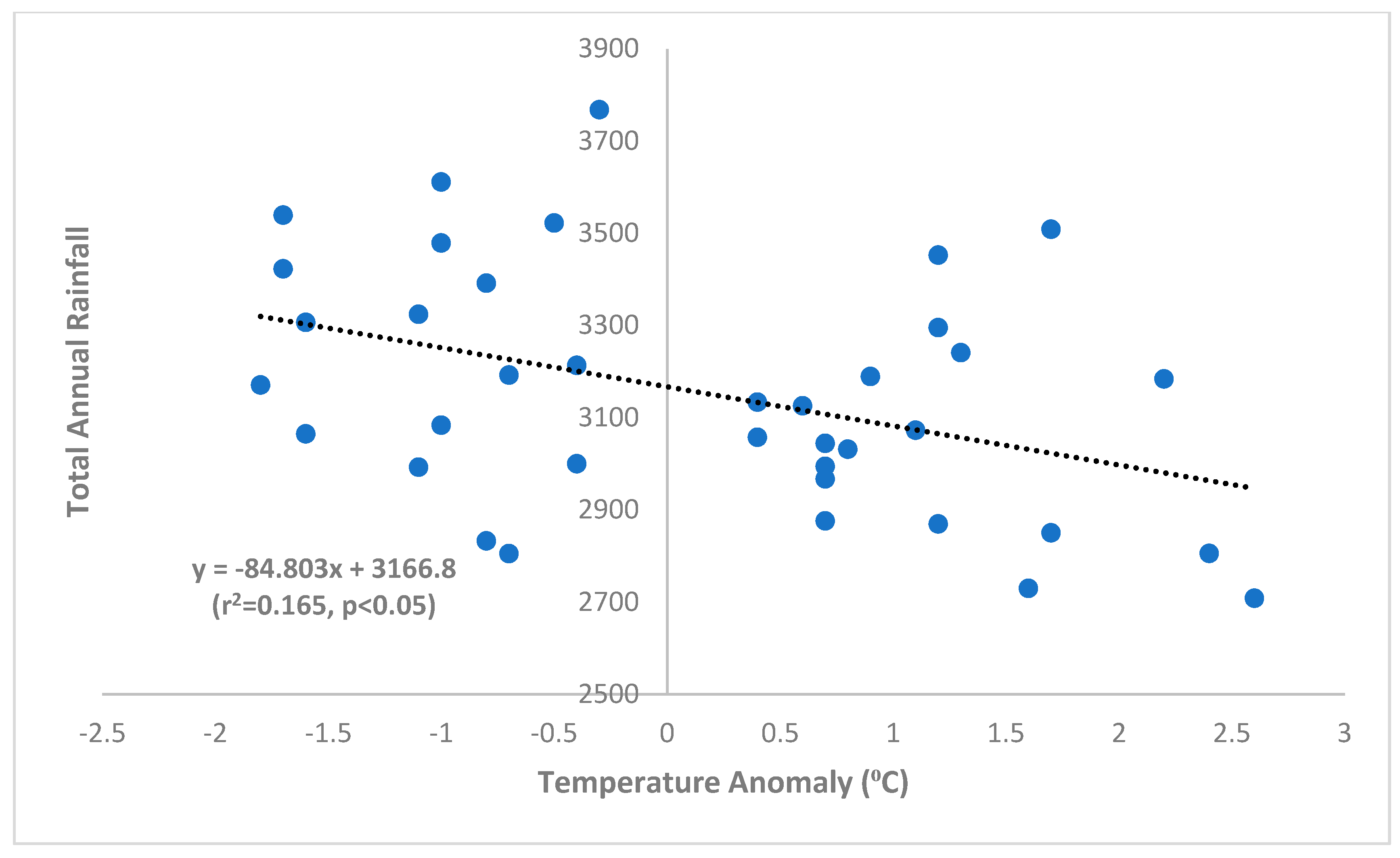
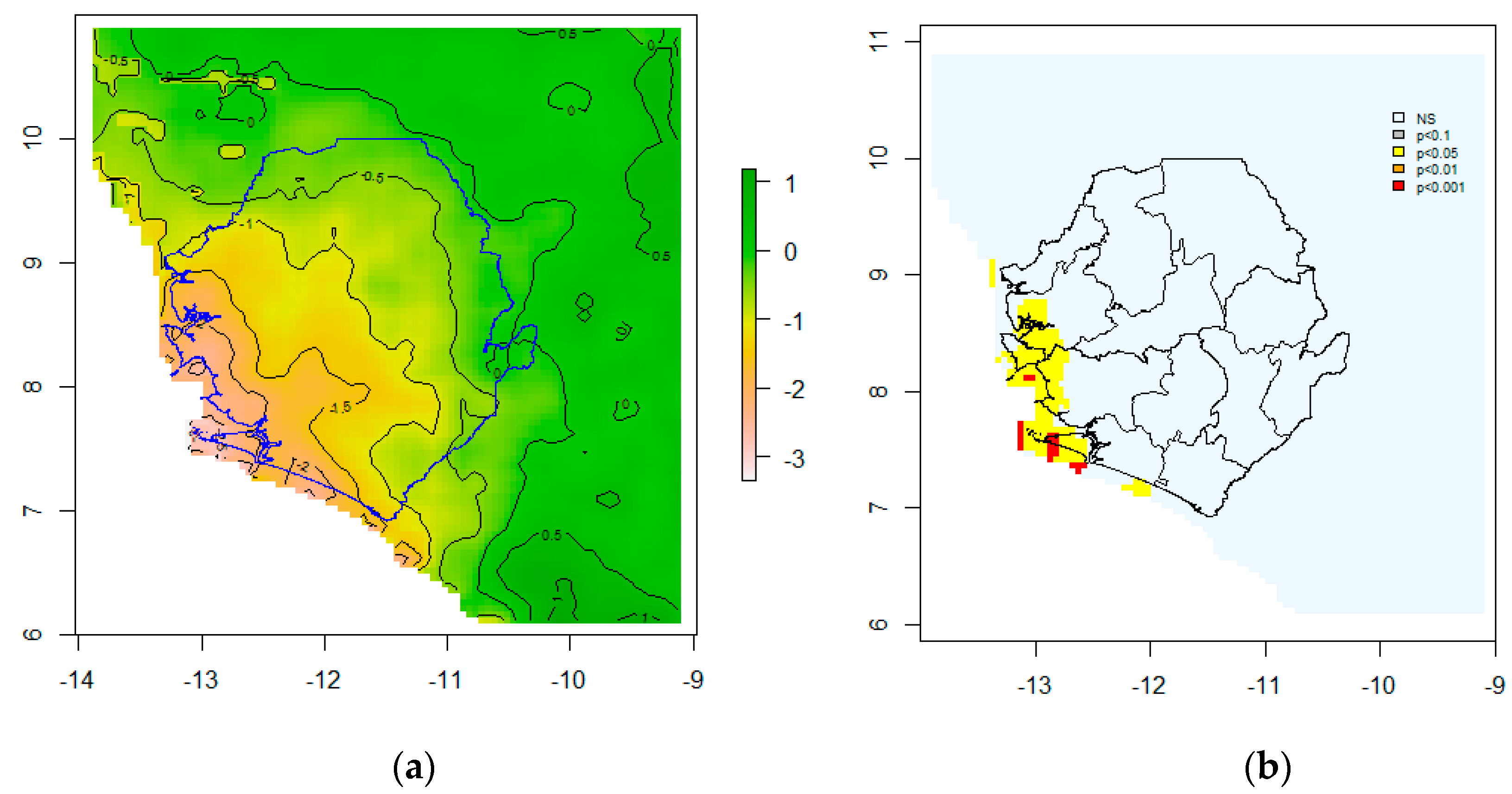
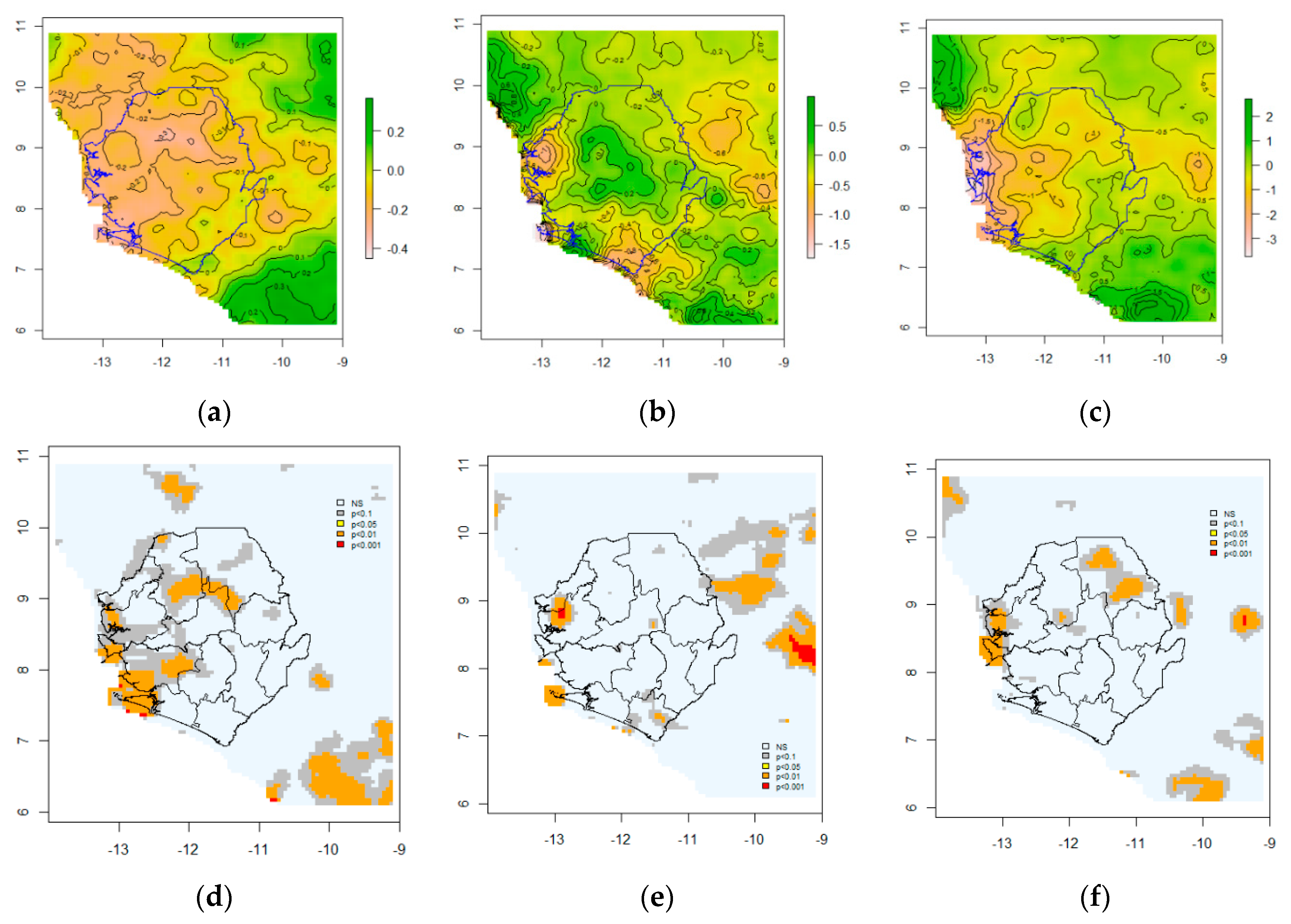
| Region | Median Rainfall mm | Trend with Time | Trend with El Niño | |||
|---|---|---|---|---|---|---|
| mm/1981–2018 | Prob’ | Variability | mm/+1 °C | Prob’ | ||
| Kambia | 2755 | −259 | 0.129 | Inc | −5.2 | 0.897 |
| Bombali | 2511 | −195 | 0.094 * | Inc | 13.8 | 0.617 |
| Koinadugu | 1987 | −81 | 0.358 | Dec | 25.3 | 0.215 |
| PortLoko | 2788 | −305 | 0.090 + | Inc | −2.9 | 0.946 |
| Tonkolili | 2896 | −278 | 0.034 * | Dec | −9.1 | 0.773 |
| Kono | 2288 | −67 | 0.452 | Dec * | −0.8 | 0.968 |
| WA | 3471 | −598 | 0.010 ** | Dec | −17.9 | 0.750 |
| Moyamba | 2766 | −260 | 0.066 + | Inc | −26.0 | 0.438 |
| Bo | 2574 | −162 | 0.113 | Dec | −19.7 | 0.413 |
| Kenema | 2540 | −25 | 0.826 | Dec | −38.6 | 0.130 |
| Kailahun | 2338 | 28 | 0.748 | Dec | −26.9 | 0.187 |
| Bonthe | 3232 | −155 | 0.353 | Dec | −56.5 | 0.140 |
| Pujehun | 3129 | 8 | 0.960 | Dec | −84.8 | 0.011 + |
| RB_A | 3126 | −605 | 0.009 ** | Dec | −0.6 | 0.991 |
| RB_B | 2745 | −233 | 0.093 + | Inc | −12.1 | 0.712 |
| RB_C | 3111 | −73 | 0.620 | Dec | −61.5 | 0.068 + |
| Region | Median Value mm | Trend over Time | Trend with El Niño | |||
|---|---|---|---|---|---|---|
| mm/yr | Prob’ | Variability | mm/°C | Prob’ | ||
| Kambia | 184 | −1.17 | 0.257 | Dec | −1.65 | 0.858 |
| Bombali | 232 | −0.89 | 0.374 | Dec | −2.08 | 0.815 |
| Koinadugu | 247 | −0.58 | 0.557 | Dec | −2.58 | 0.770 |
| PortLoko | 216 | −1.45 | 0.169 | Dec | −1.85 | 0.844 |
| Tonkolili | 298 | −1.12 | 0.345 | Dec | −7.33 | 0.485 |
| Kono | 348 | −0.47 | 0.676 | Dec * | −5.06 | 0.608 |
| WA | 226 | −2.03 | 0.103 | Dec | −5.17 | 0.644 |
| Moyamba | 279 | −1.63 | 0.196 | Inc | −9.57 | 0.395 |
| Bo | 311 | −1.49 | 0.214 | Dec + | −5.19 | 0.628 |
| Kenema | 345 | −1.18 | 0.414 | Dec | −8.09 | 0.528 |
| Kailahun | 376 | −0.10 | 0.936 | Dec * | −4.84 | 0.661 |
| Bonthe | 295 | −1.87 | 0.171 | Inc | −14.02 | 0.246 |
| Pujehun | 362 | −1.02 | 0.457 | Dec + | −12.40 | 0.305 |
| RB_A | 186 | −1.71 | 0.114 | Dec | −2.64 | 0.786 |
| RB_B | 237 | −1.11 | 0.287 | Dec | −3.58 | 0.699 |
| RB_C | 301 | −1.60 | 0.210 | Dec | −10.19 | 0.368 |
| Region | Median Day | Change over Time | ||
|---|---|---|---|---|
| Change 1981–2018 | Prob’ | Variability | ||
| Kambia | 124 | 11.0 | 0.240 | Inc |
| Bombali | 117 | 8.1 | 0.177 | Dec + |
| Koinadugu | 118 | 11.6 | 0.221 | Dec + |
| PortLoko | 119 | 9.3 | 0.201 | Dec * |
| Tonkolili | 109 | 14.7 | 0.294 | Inc * |
| Kono | 89 | −2.6 | −0.040 * | Inc |
| WA | 118 | 5.0 | 0.109 | Dec * |
| Moyamba | 117 | 3.9 | 0.079 + | Dec + |
| Bo | 111 | 15.1 | 0.335 | Dec |
| Kenema | 97 | 21.2 | 0.306 | Inc |
| Kailahun | 86 | −1.2 | −0.022 * | Inc |
| Bonthe | 116 | 14.0 | 0.239 | Inc |
| Pujehun | 106 | 15.9 | 0.352 | Inc |
| RB_A | 124 | 12.2 | 0.260 | Inc |
| RB_B | 119 | 10.4 | 0.220 | Dec |
| RB_C | 113 | 12.8 | 0.238 | Dec |
| Region | Number of Days with Rain >10 mm | Growing Season (Days) | ||||||
|---|---|---|---|---|---|---|---|---|
| Change | Change | |||||||
| Median | Days/Year | Days/°C | Variability | Median | Days/Year | Days/°C | Variability | |
| Kambia | 90 | −0.17 | −1.40 | Inc * | 240 | −0.20 | −0.13 | Dec |
| Bombali | 88 | −0.29 * | −0.75 | Inc | 240 | −0.12 | 2.34 | Dec |
| Koinadugu | 78 | −0.21 + | −0.18 | Dec | 243 | −0.07 | −1.76 | Inc |
| PortLoko | 92 | −0.20 | −1.47 | Inc * | 245 | −0.13 | −0.12 | Dec |
| Tonkolili | 97 | −0.19 | −1.62 | Dec | 244 | −0.40 + | 1.41 | Dec + |
| Kono | 94 | −0.17 | −0.42 | Dec * | 260 | 0.18 | −2.37 | Inc |
| WA | 94 | −0.25 + | −1.92 | Dec | 274 | −0.13 | 1.73 | Dec |
| Moyamba | 91 | −0.25 + | −2.06 + | Dec + | 247 | −0.03 | 0.78 | Dec |
| Bo | 89 | −0.20 + | −1.11 | Dec + | 251 | −0.27 + | 0.91 | Dec + |
| Kenema | 90 | −0.06 | −2.18 * | Dec | 258 | −0.43 + | −1.76 | Dec + |
| Kailahun | 91 | 0.00 | −0.82 | Dec * | 270 | 0.12 | −1.37 | Inc |
| Bonthe | 90 | −0.14 | −2.71 * | Dec ** | 282 | −0.37 + | 2.84 | Dec + |
| Pujehun | 94 | −0.10 | −3.78 ** | Dec * | 252 | −0.41 * | −0.86 | Dec * |
| RB_A | 94 | −0.25 * | −1.55 | Inc + | 265 | −0.15 | −1.48 | Dec |
| RB_B | 93 | −0.21 | −1.24 | Inc + | 239 | −0.19 | −1.15 | Dec |
| RB_C | 91 | −0.13 | −2.45 * | Dec ** | 245 | −0.25 | 1.55 | Dec |
| Region | One-Day Totals | Seven-Day Totals | ||||||
|---|---|---|---|---|---|---|---|---|
| Median mm | Change | Median mm | Change | |||||
| mm/yr | mm/°C | Variability | mm/yr | mm/°C | Variability | |||
| Kambia | 188.3 | −0.51 | 2.21 | Dec * | 311 | −1.1 | 10.4 | Inc |
| Bombali | 134.3 | 0.31 | −0.20 | Inc * | 261 | −0.6 | 3.8 | Inc +. |
| Koinadugu | 93.1 | −0.14 | 0.76 | Dec + | 183 | −0.7 + | 1.2 | Dec + |
| PortLoko | 183.8 | −0.57 | 2.84 | Dec * | 306 | −1.9 | 11.1 | Dec + |
| Tonkolili | 152.0 | 0.14 | −0.56 | Dec | 305 | −1.4 + | 8.3 | Dec + |
| Kono | 109.5 | 0.05 | −0.04 | Dec | 195 | −0.4 | −0.8 | Inc + |
| WA | 248.3 | −0.56 | 6.14 | Dec | 399 | −3.5 * | 9.2 | Dec ** |
| Moyamba | 162.6 | −0.24 | 2.12 | Inc | 287 | −1.3 | 6.9 | Dec |
| Bo | 143.5 | −0.26 | 1.72 | Dec * | 244 | −1.0 | 2.9 | Inc |
| Kenema | 176.2 | −0.21 | −1.43 | Dec *** | 239 | 0.0 | −0.2 | Inc |
| Kailahun | 130.3 | −0.17 | −0.77 | Dec * | 198 | −0.3 | 0.5 | Inc |
| Bonthe | 217.4 | 0.02 | 0.56 | Dec | 358 | −0.6 | 4.3 | Inc |
| Pujehun | 245.2 | −0.86 + | 2.73 | Dec *** | 325 | 0.0 | −2.5 | Inc |
| RB_A | 239.2 | −0.95 | 2.12 | Dec* | 407 | −3.0 * | 9.1 | Dec + |
| RB_B | 160.3 | 0.22 | 0.59 | Dec | 284 | −1.3 | 7.3 | Dec |
| RB_C | 233.3 | −0.29 | 4.48 | Dec ** | 327 | −0.1 | 2.2 | Inc * |
© 2019 by the authors. Licensee MDPI, Basel, Switzerland. This article is an open access article distributed under the terms and conditions of the Creative Commons Attribution (CC BY) license (http://creativecommons.org/licenses/by/4.0/).
Share and Cite
Wadsworth, R.; Jalloh, A.; Lebbie, A. Changes in Rainfall in Sierra Leone: 1981–2018. Climate 2019, 7, 144. https://doi.org/10.3390/cli7120144
Wadsworth R, Jalloh A, Lebbie A. Changes in Rainfall in Sierra Leone: 1981–2018. Climate. 2019; 7(12):144. https://doi.org/10.3390/cli7120144
Chicago/Turabian StyleWadsworth, Richard, Amie Jalloh, and Aiah Lebbie. 2019. "Changes in Rainfall in Sierra Leone: 1981–2018" Climate 7, no. 12: 144. https://doi.org/10.3390/cli7120144
APA StyleWadsworth, R., Jalloh, A., & Lebbie, A. (2019). Changes in Rainfall in Sierra Leone: 1981–2018. Climate, 7(12), 144. https://doi.org/10.3390/cli7120144





